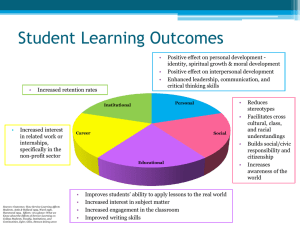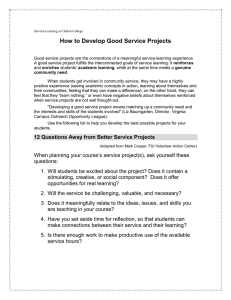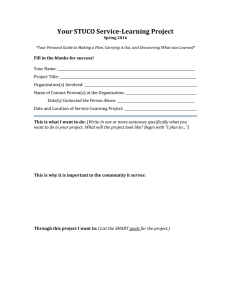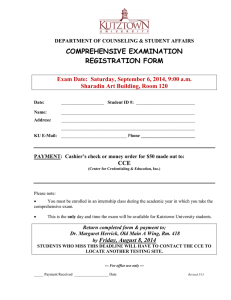Blueprint for Academic Service-Learning Course Development
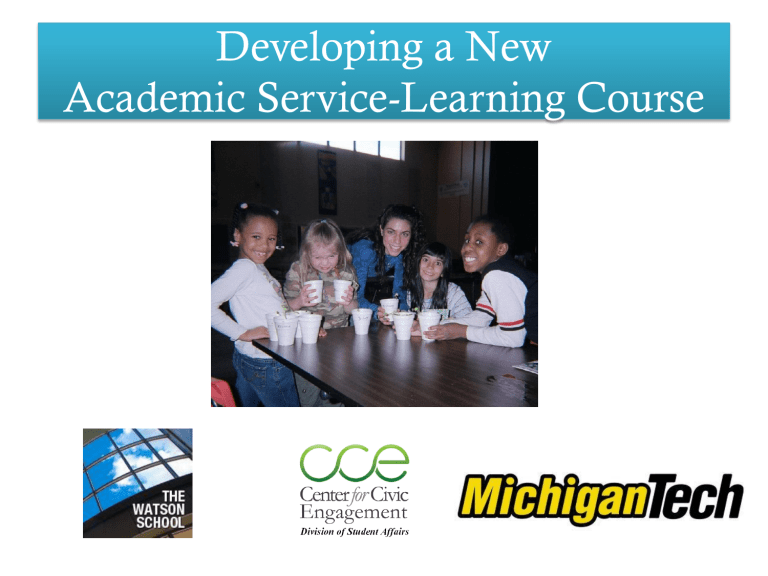
Developing a New
Academic Service-Learning Course
What is Academic
Service-Learning (ASL)?
• Academic service-learning
– A teaching method that combines community service with academic instruction, focusing on critical, reflective thinking and civic responsibility.
• An academic service-learning course:
• Uses experiential strategies characterized by student participation in an organized service activity
• Is connected to specific learning outcomes
• Meets identified community needs
• Provides structured time for students to analyze and connect the service experience to learning
• Adapted from: Heffernan, K. (2001). Fundamentals of servicelearning course connection. Providence: Campus Compact.
Getting Started
•
Goals today
– Provide each of you with a formulaic approach;
– Examples in engineering and the humanities;
– Ask you to participate each step of the way; and
– Establish a Circle of Trust in which we all share.
Some Questions for Reflection
•
What is/are the purposes of higher education?
– Is it to generate wealth?
– Is it to enable students to become model employees?
– Or is it something else?
– Your thoughts?
•
Why are we university faculty members?
– Again, your thoughts?
Making Connections with
Academic Service-Learning
•
I would suspect that..
– we each care about the quality of the education we provide; and
– we want to make a difference in the world.
•
I would submit that service learning does both equally well.
•
Let’s begin!
Academic Service-Learning
Across the University
• Humanities
– BU Scholars Program
– SCHL 280 Peace : An Historical Reflection
• 4 credit hour course
• Gen Ed: H
• Fall 2011
• Engineering
– BE 450/451 Senior Level Capstone Design
• 2 semesters
• 4 credit hours per semester
• Requires a major design experience
BU Scholars Program
SCHL 280 Peace : An Historical Reflection
• Partnerships in BU Scholars Program
• The Rescue Mission (http://rescuemission.net/)
• The Rescue Mission is a grassroots organization offering programs to help people physically, psychologically, socially and spiritually.
• The programs are holistic and involve the elements of personal responsibility, self-determination and an internal transformation of values and vision resulting in a restoration of self-respect. The homeless, the hungry, the sick, the addicted, the abused and the hopeless have all found a warm welcome at the Rescue Mission.
Men, women and children have found a safe place and compassionate friends in their darkest moments.
Engineering
BE 450/451 Senior Level Capstone Design
• Partnerships in Capstone Bioengineering
• TRAID Program in NYS ( http://cqc.ny.gov/advocacy/assistivetechnology/traid-program )
• TRAID’s goal is to increase the access and acquisition of assistive technology in the four domain areas of education, employment, community living and information technology/telecommunications.
Through the 12 Regional TRAID Centers (RTCs), staff provide information, training, device demonstration and loan, technical assistance and advocacy on how to obtain and use assistive technology services and devices. The TRAID Program, in collaboration with the
NYS Department of Health Early Intervention Program, provides partial funding to the RTCs for equipment loan libraries for infants and toddlers with disabilities and their families.
Engineering
BE 450/451 Senior Level Capstone Design
• Partnerships in Capstone Bioengineering
• Corazon de Dahlia (http://www.corazondedahlia.org/)
• To collaborate with Peruvian communities to facilitate sustainable, healthy development and provide educational opportunities to empower children and families.
• “We provide children and families with opportunities for social and academic enrichment, emphasizing respect for the people and land around them. Children thrive when they have a structure in place where they are nurtured and feel safe from physical and sexual abuse. Our
Center for the Promotion of Child & Family Development is a social and educational project, in which we will develop skills and values through various outlets such as social development, cultural awareness, literacy proficiency, and mental health. We will improve the quality of life for children, families, and the society at large by offering tangible alternatives in order to advance their education through training, guidance, counseling, and support.”
Step One: Course Outline
• Develop a brief description of your course
– What type of course do you want to develop?
– What are the goals and learning outcomes of the course?
– In what way(s) do you want to incorporate service-learning?
Step Two: Stakeholders
For consideration…
• For whom are you creating value or benefits?
• Who are your most important stakeholders?
Students
Community Members
Colleagues
Alumni
Administrators
NGOs
Businesses
Government
Universities
Public
Other
Step Two: Impacts and Benefits
• What impact will your ASL course have on each stakeholder?
• Which of your stakeholders’ problems are you helping to solve?
• What services (or products) are you offering to each stakeholder segment?
• Which stakeholder needs are you satisfying? How will they benefit?
Practical assistance towards a sustainable community?
Community-based services
Infrastructure development
Professional development
Student retention
Enhanced learning
Other
SCHL 280 Peace : An Historical Reflection
BE 450/451 Senior Level Capstone Design
Step Three: Key Activities
- What key activities need to take place for each stakeholder to benefit?
- Think about each stakeholder specifically and how you will interact with them to maintain your relationship.
Information Sessions
Direct engagement with stakeholders
Research/education
Community Project
Public Symposium
Other
Step Four: Key Resources
• What key resources do you require to ensure each stakeholder benefits?
• What key resources do you need to maintain your stakeholder relations?
Physical resources (equipment)
Information resources
Human resources (knowledgeable community members)
Financial resources
A brand (your program/university’s reputation)
Trust (long-term relationships, positive past experiences)
Other
SCHL 280 Peace : An Historical Reflection
BE 450/451 Senior Level Capstone Design
For Consideration: Value Streams
Returns
• For what value are your stakeholders willing to “pay?”
• What do they currently contribute or pay for?
• How and in what form will your stakeholders return value?
• How would your stakeholders prefer to contribute?
• How much does each value stream contribute to the overall success of your program?
Supporter donations for program costs
Scholarly publications for faculty
Media coverage to promote program
Professional development for students
Health benefits for the community
Other
For Consideration: Value Streams
Costs and Outlays
- What are the most important costs inherent to your program value?
- Which key activities are most expensive and in terms of what value?
- Which key resources are most expensive and in terms of what value?
Tuition
Time, energy, enthusiasm
Activities that place value at risk
Economies of program scale
Economies of program scope
Other
ASL Resources in the CCE
• The Basics
– The CCE website has many relevant articles and links that outline the basics of incorporating academic service-learning (ASL) into one’s curriculum. The website also lists online resources and links to other organizations on campus that are relevant to civic engagement at http://www2.binghamton.edu/cce/resources/
• Terminology
– To access a list of terms commonly used when studying and/or utilizing service-learning and civic engagement on campus please visit http://www2.binghamton.edu/cce/terms-and-definitions.html
• Research and Reports
– The CCE relies on published research and reports on service-learning, civic engagement, and volunteerism for decision-making processes.
– These can be viewed at http://www2.binghamton.edu/cce/ccereports.html
ASL Resources in the CCE
• Faculty FAQ
– The CCE has compiled a list of frequently asked questions about service-learning and starting civically engaged higher education courses that can be found at http://www2.binghamton.edu/cce/faculty/slfaq.html
• CCE Lending Library
– Library in the office open to faculty and staff use
– Over 300 books in areas including service-learning, research and journals of community service, student development and MORE!
Starting a Dialogue
• Questions?
• Hopes
• Fears
• Hesitations
• Anxieties
• Contact Information
• Center for Civic Engagement | Binghamton University
Library South Ground Floor 548
Phone: (607) 777-4287 | Fax: (607) 777-3099
Email: cce@binghamton.edu
• George Catalano PhD
• Watson School, Bioengineering
• BI 2614
• catalano@binghamton.edu
• Jacqueline Fritsch
• Graduate Assistant
• Center for Civic Engagement
• Library South Ground 548
• jfritsc2@binghamton.edu
References
• This handout is an adapted version of the Learning Through
Service Program Model Blueprint developed by Kurt Paterson,
PhD, Associate Professor of Civil and Environmental
Engineering at Michigan Tech
• Learning Through Service Program Model Blueprint by K.G. Paterson is licensed under a Creative Commons Attribution-NonCommercial-ShareAlike
3.0 Unported License. Based on works at http://businessmodelgeneration.com and http://weblog.tetradian.com
